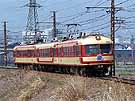
Sweeping a gentle curve is a series 2000 Yudanaka-link
limited express showing its beautiful shape. This type, first
introduced in 1957, has long been the Nagano Dentetsu's most
distinctive stock. Its sleek style still seems novel despite its age.
This series received refurbishment in 1989 and was equipped with
air-conditioners.
|
Nagano Dentetsu
(Nagano Electric Railway)
By Hiroshi Naito
Nagano is a city developed in a basin, known as the Zenkoji Daira,
located in the central part of the main island of Japan, about 250 km
northwest of Tokyo. As a prefectural capital, with its population of
350,000, Nagano thrives as the commercial and industrial center of the
prefecture. Also it is well known to the world because of the 1998
Winter Olympic Games held in the city and its vicinity. It can be
easily accessed from Tokyo after a journey of about two hours and
twenty minutes by the Nagano Shinkansen, which was completed in 1997 in
time the Olympic Games. With a number of tourist resorts located in the
mountainous areas surrounding the basin, Nagano city is situated as a
strategic point of the area's sightseeing activities.
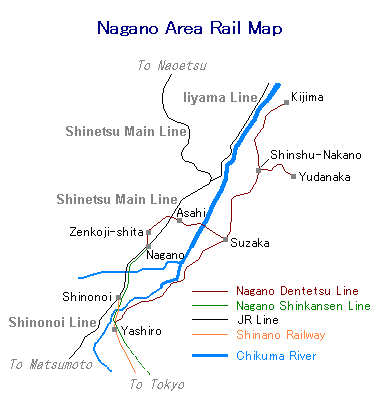 The Nagano
Dentetsu (Nagano Electric Railway) is a regional private rail service
that covers the city's suburban areas and some cities and towns
scattered in the basin. The railway's main service route is between
Nagano and Yudanaka, known as a great hot spring resort and the
entrance to the Shigakogen (Shiga Plateau) skiing resort. Series 2000
3-car limited express trains in a two-tone livery of red and cream
connect both termini in 50 minutes to carry sightseers. Regular
services on the main line and branch lines are by stainless-steel made
series 3500 cars, ex-Eidan Subway's type 3000 cars that flourished in
the late 60s through the 80s on the Hibiya Line. The railway once used
to use other types, but currently, its fleet consists of these two
types of rolling stock.
The Nagano
Dentetsu (Nagano Electric Railway) is a regional private rail service
that covers the city's suburban areas and some cities and towns
scattered in the basin. The railway's main service route is between
Nagano and Yudanaka, known as a great hot spring resort and the
entrance to the Shigakogen (Shiga Plateau) skiing resort. Series 2000
3-car limited express trains in a two-tone livery of red and cream
connect both termini in 50 minutes to carry sightseers. Regular
services on the main line and branch lines are by stainless-steel made
series 3500 cars, ex-Eidan Subway's type 3000 cars that flourished in
the late 60s through the 80s on the Hibiya Line. The railway once used
to use other types, but currently, its fleet consists of these two
types of rolling stock.
Nagano's Zenkoji Basin is divided into the eastern area and western
area by the Chikuma River, another name of the great Shinano River, the
longest river in Japan, for its upstream part. The western area
benefited early from the national railway's Shinetsu Main Line that
opened in 1893. People in the eastern area longed for rail service and
established a private railway, with its initial segment opened in 1920.
The service was extended segment by segment, and completed the current
form of the Nagano Dentetsu routes in 1926, reaching Nagano by crossing
the Chikuma River. Now, the Nagano Dentetsu consists of three lines,
the Koto Line covering the 50.4 km between Yashiro and Kijima, the
Nagano Line covering the 12.5 km between Suzaka and Nagano, and the
Yamanouchi Line covering the 7.6 km between Shinshu-Nakano and
Yudanaka, totaling a service route length of 70.5 km. The limited
express services from Nagano targeting tourists cover the Nagano Line
and the Yamanouchi Line up to Yudanaka with hourly operation. Frequent
services for commuters and regular passengers operate mostly between
Nagano and Shinshu-Nakano every 15 minutes. The Yashiro Line and the
Koto Line's Shinshu-Nakano to Kijima section are quietly served by
hourly operation. The Nagano Line's Nagano to Asahi section, 6.3 km,
features double track, but all other routes are on single track.
Particularly, the first 2.3 km from Nagano to Zenkoji-shita is an
underground section completed in 1981 to eliminate level crossings,
thus resolving the worsened traffic congestion in the city center area.
The track is entirely on 1,067 mm narrow gauge, and is electrified on
1500v DC. All the traffic is controlled from Suzaka by CTC, and the
trains are protected by ATS over the entire length of the routes. If
you ride a train from Nagano, after the underground section, a suburban
ambience continues for a while, but only as far as Asahi, where the
double track section ends. The scenery along most parts of the lines is
rustic enough and full of rice paddies and apple orchards.
Particularly, one may feel rather desolate about the Koto Line's
Shinshu-Nakano to Kijima section and Suzaka to Yahiro section due to
the quiet service frequency along with rural scenery alongside the
track. Reportedly, the Shishu-Nakano to Kijima section is being
abandoned soon this year or next year.
The Nagano Dentetsu was once more prosperous with tourists coming to
the sightseeing spots and hot spring resorts in the region represented
by the Shigakogen. There even used to be through expresses from
Ueno/Tokyo served by the JNR's 165 series EMUs which came via the
southern terminus of Yashiro, where the rail was linked to the Shinetsu
Main Line. As automobiles became the more common mode of transportation
with the growth of expressways, this unique service was discontinued in
1981. The position of Yashiro further declined due to the opening of
the Nagano Shinkansen. The Shinetsu Main Line suffered from segment
discontinuance between Karuizawa and Shinonoi (Yashiro is en-route on
this section), although the third sector Shinano Railway took over the
service on this segment. Now, no rail link exists at Yashiro to the
Shinano Railway.
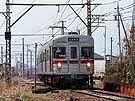
Leaving a loop is a series 3500 local train. With the first
transfer from Eidan Subway in 1993, this series has become the most
common stock of the Nagano Dentetsu fleet.
|
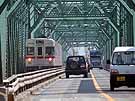
The Chikuma River is crossed by a great combined road and rail truss bridge on the Nagano Line.
|
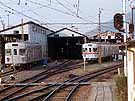
Series 3500 is dominant all over the Nagano Dentetsu territory. Viewing the depot, at Suzaka.
|
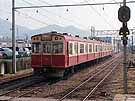
Already withdrawn 0 series Kuha 51 in combination with Moha 1
introduced in1967, at Suzaka. This series was quite innovative as a
regional railway's stock with its powerful performance and four-door
commuter train style.
|
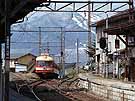
A 2000 series limited express is rolling onto Yudanaka terminus finishing the final approach on a gradient as steep as 4%.
|
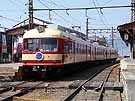
A 2000 series limited express takes a rest before returning
from Yudanaka terminus. Yudanaka is the entrance to the Shigakogen
resorts for tourists coming by rail.
|
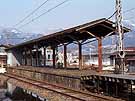
Kijima station is very quiet with only a few passengers on a
Saturday afternoon. Waiting for a departure in a lonely ambience is a
Shinshu-Nakano-bound 2-car 3500 series local.
|
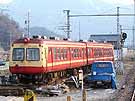
Seen in a siding on the Koto Line south of Suzaka is a
withdrawn ex-Tokyu car, which used to run on the Toyoko Line as 5000
series from the 50s through 60th.
|
|
All photos in this page were taken by the author in April 2001.
UPDATE:
Since this article was written the Shinshū-Nakano to Kijima line was
closed in 2002; the Suzaka to Yashiro line closed on 31 March 2012 both
due to declining patronage. This leaves the Nagano to Yudanaka main
line as the only section still in operation.
[Home Page]

 The Nagano
Dentetsu (Nagano Electric Railway) is a regional private rail service
that covers the city's suburban areas and some cities and towns
scattered in the basin. The railway's main service route is between
Nagano and Yudanaka, known as a great hot spring resort and the
entrance to the Shigakogen (Shiga Plateau) skiing resort. Series 2000
3-car limited express trains in a two-tone livery of red and cream
connect both termini in 50 minutes to carry sightseers. Regular
services on the main line and branch lines are by stainless-steel made
series 3500 cars, ex-Eidan Subway's type 3000 cars that flourished in
the late 60s through the 80s on the Hibiya Line. The railway once used
to use other types, but currently, its fleet consists of these two
types of rolling stock.
The Nagano
Dentetsu (Nagano Electric Railway) is a regional private rail service
that covers the city's suburban areas and some cities and towns
scattered in the basin. The railway's main service route is between
Nagano and Yudanaka, known as a great hot spring resort and the
entrance to the Shigakogen (Shiga Plateau) skiing resort. Series 2000
3-car limited express trains in a two-tone livery of red and cream
connect both termini in 50 minutes to carry sightseers. Regular
services on the main line and branch lines are by stainless-steel made
series 3500 cars, ex-Eidan Subway's type 3000 cars that flourished in
the late 60s through the 80s on the Hibiya Line. The railway once used
to use other types, but currently, its fleet consists of these two
types of rolling stock.






